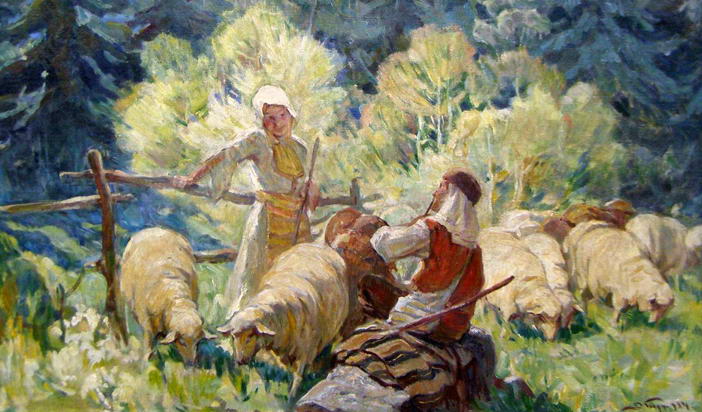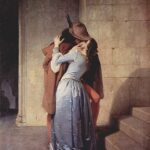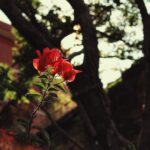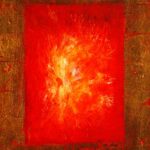“The day before yesterday I saw a rabbit, and yesterday a deer, and today, you”
The Dandelion Girl by Robert F. Young
Love is a sense of being; it is everything. It weaves and spreads and weaves beneath the ground, pulling the souls of our feet, until one day it decides to surface, tempted by water, tempted by air; to reach out its tender hands through the soil, for merging.
Love is the immortal face of our beloved, transcending time and space.
In fact, one of the greatest teachings of Jesus, whose entire life was dedicated to show us unconditional love, empathy, kindness and compassion, can be found in his final moment as he rises before Mary Magdalene. She reaches out her hand to him and he says, “Noli me tangere.” Translated from Latin as “Don’t touch me.” This symbolizes that love in its essence is not something to be touched to be felt; that we must finally realize that love is our very nature, sense of being, transcending the physical senses. It means that we can’t cling nor possess because true love is unconditional and its only requirement is: to just be. If we love someone only because of how they feel or act towards us, it’s not love. Love is not there to please us or make us happy; it’s there to shift us, grow us, transform us and often times this means it will bring us to our knees. I once knew a man who told me: “I love you. You don’t have to say it back to me, you don’t have to feel it as well. I just love you because that’s just how I feel – and that’s all I care about.”
Each relationships goes through its phases and while we may think that just because passion fades with time, it is no less beautiful, no less “passionate” – it is different yet deep and meaningful as the first time. Love is wild and unpredictable, turbulent, intense and emotional, and often speechless and unseen. And often times, love is a mystery because it transcends definitions, shoulds and should-nots.
The greatest paradoxes of life is that the more intimate and connected we are with a partner – the less desirous they become to us as the years go by.
When it comes to love, we long to connect deeply; to close the gap that exists between us by intimacy, by vulnerability and by bonding. Yet desire demands space – because it is about “wanting” and how could we want something, which we already have close? Desire, by its very nature, needs a space to thrive and a distance to explore.
The inescapable fate of desire is that intimacy lowers its strength. There is a fundamental tension between the reconcialiation of these two needs, closer yet apart, within each relationship.
Think about the time when you felt desirous towards a partner. It is when we see them in a new light like when we go on a vacation, or see them from a new angle from across the room, or when we see them laughing at something new – or in other words, when we see them playful or from a distance, in surprising ways outside of the expected monotony.
It’s a looking without eyes.
When comfort and mystery, known and unknown momentarily meet, when the person we’ve known for years suddenly is at just enough distance to surprise us in some mystical, elusive way – is where the desire is found once again.
Everything in life is a relationship and we need to honour that.
Everything in life begins with noticing.
The great theologian and philosopher, Augustine once defined love as: “Amo: Volo Ut Sis”. Translated from Latin, this means “I Love: I Will That You Are”. What this implies is that the only thing love required was for us to just “be”; as love is about full acceptance; of ourselves and others.
The willing ego when it says “I want/will you to be” in its highest manifestation is not out of a space of possession but rather to show itself capable of an unconditional, divine love – like how God created humans and loves them without desiring them to be a specific thing; he created them only because he willed them to exist.
What this means within a relationship is acceptance; accepting our lover as they are with the absolute awareness that no one is our property and that all of us change. It means: I love you and all your parts. I want you to just be. I want every moment for you. I love your mere existence in my life. I love your being.
I’ve often felt that the greatest lovers are the ones who know how to pay attention. They are imaginative, creative and experts at the art of noticing. Because to continue to nurture a love, we need to take care of it daily.
I repeat: pay attention.
This means to see beyond the strained smiles when they come home from work, to see the stress or sadness in their eyes, and while all seems well, to take their hands into ours, and gently say, “Tell me, my love.”
This means putting down the phone, switching off the TV, and saying, “My love, let me take you out to that place you wanted to go to.”
To pay attention means holding, kissing, touching, speaking, caressing, not the way you always did but the way your beloved needs to be – right now, today.
To pay attention means that we love our partner and accept them as they are; fully accepting all of their parts, present and gone, shiny and dark, because all of us constantly change. It means that we’ll have to sit by their side throughout sadness, failures and rejections. It means we’ll sit beside them and together, holding their hand, say goodbye to all their dreams that never happened, and the people that they never became; that we’ll mourn all these many selves and parts that will go away through the years.
And we love them, still and through it all.
Love that pays attention sees the beauty of our lover every single day, and is responsible, accountable and alive to it. And when we pay attention – we fall in love over and over again because we hold the eyes of gratitude, discovering new shades in our partner, like art.

The Dandelion Girl is a beautiful short story written by Robert F. Young in 1961. Here’s a summary of it:
A married middle aged man, Mark Randolph, is forced to spend his next vacation without his wife Anne (because she is sent to jury duty). He drives to a remote town in the outskirts where one day he meets a 21 years old beautiful girl on the top of a hill, with blue eyes and dandelion gold hair. Her name is Julie and she claims to be from the future. Her father built a time-travel machine and she loves this hill, so each day she comes back,
“The day before yesterday I saw a rabbit, yesterday a deer, and today, you.”
Julie explains to him that time travelling doesn’t disrupt anything that occurred in the past. According to her father’s concept, the book of time has already been written.
From a macrocosmic viewpoint, everything that is going to happen has already happened. Therefore, if a person from the future participates in a past event, he becomes a part of that event—for the simple reason that he was a part of it in the first place—and a paradox cannot possibly arise.
The next few days they spend time together and Mark starts to feel uneasy because he starts to fall for Julie. Each day more and more, the more they talk and share their time together. Until one day Julie tells him that she won’t be able to return anymore because the time machine is running down.
But you’ll try to come, won’t you?”
She nodded. “Yes, I’ll try. And Mr. Randolph?”
“Yes, Julie?”
“In case I don’t make it—and for the record—I love you.”
Unable to say anything back to her, and with his hands trembling, he returned home to his cabin. The next few months were a blur and he couldn’t stop thinking of her. He kept visiting the hill but she never came back. Thanks to a random set of events, he discovers the old suitcase of his wife, Anne, whom he met when she came to his office to apply for a job over 20 years ago; it was love at first sight for him. And in the suitcase, he sees the same white dress that Julie wore the first day on the hill. He realizes that Anne is Julie; that Julie did come back once last time – 20 years back – to the time when Mark was her age also.
All alone in a strange generation, not knowing for sure whether the concept of time was valid, not knowing for sure whether Mark, the man who would love her in his forties would feel the same way toward her in his twenties – she came back. Just as she wasn’t sure that he’d love her in his 40s today … when she is also in her 40s …
Suddenly he realized why his wife had sadness and fear in her eyes these past few months.
“Didn’t she realize that in his eyes she couldn’t grow old—that to him she hadn’t aged a day since the moment he had looked up from his desk and seen her standing there in the tiny office and simultaneously fallen in love with her? Couldn’t she understand that that was why the girl on the hill had seemed a stranger to him when he first saw her?
He ran out to meet his wife in the rain; the dandelion-hued hair was darker now and her girlish charm was gone; but the gentle loveliness still resided in her gentle face, and her legs has a grace in the pale glow of the November street light that they had never known in the golden radiance of the September sun. She blurred before his eyes, and he walked toward her blindly. When he came up to her, his eyes cleared, and he reached out across the years and touched her rain-wet cheek. She knew it was all right then, and the fear went away forever, and they walked home hand in hand in the rain.”
“The day before yesterday I saw a rabbit, yesterday a deer, and today, you.”
In this beautiful line lies the very core of the story: love transcends time.
Each day, Julie sees something beautiful and substantial in its intrinsic meaning to her. Yet each day that follows, is even more significant; not taking away from the previous in its beauty, only noticing another layer, deeper, or metaphorically, grander in its substance, unfolding beyond the veil of her eyes. This is similar to love; it often humbly begins from chance meetings, and then maturing into something meaningful when carefully nurtured and properly cultivated.
Another thing we see with this line is that the rabbit represents his wife in her youth as portrayed by Julie, the deer represents the maturation as portrayed by Anne, and his most significant realization, the “you”, represents the wholeness of his love allowing him to move forward with his wife; he finally sees all of her, truly as she is, not the then but the right now, without looking away. He finally remembers to pay attention and to come into appreciation of the present moment.
Each day we see something beautiful, yet it is only with our heart and the wonder of our eyes, that will allow us to truly see the newly discovered beautiful surpassing the previous; not taking away its meaning but simply, appreciating its depth with noticing, even when it is on the same hill with the same person.
This is magic.
This is the art of loving.
The story’s narrative is reminiscent of many other tales throughout cultures and history; of the ever-weaving thread of fate binding the souls of lovers across reincarnations. Whether or not that’s true, is not up to us because life never needed our valiation for its existence – and being just humanbeings with conditioned understanding, we really don’t know much at all; we have to allow ourselves the art of unknowing. How is a grain of sand to know it is a part of a desert? What I do know is this: some people are fated to meet and always do no matter what. Like rivers flow to sea, what is will always be. I’ve had many experiences throughout my life that have shown this to be true for me.
This is the difference between fate and destiny. No matter how many twists and turns we take in life, some things are written. My height is my fate but what I do with that is my destiny, or what some call character. There are people whom we are fated to meet and we will meet – but what happens afterwards is the choices we both make together; the effort, dedication, devotion and nurturing are all up to us. Love is the beautiful marriage between fate and destiny. And a little bit of magic too; to have the heart and eyes to turn the ordinary into extraordinary, and appreciate it.
Today is April 30th and after I read The Dandelion Girl in the morning, I went out for a walk. And I saw a rabbit. I wonder what I’ll see tomorrow.

For more of my writings, browse through my Art of Love.
If you wish to support me and my work, you may do so by sharing it or donate here. For personal readings with me, you may visit my Offerings.
Your support means so much to me! Thank you wholeheartedly!




